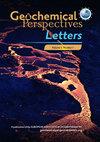Fe-C-O熔炼实验岩心组成的液相约束
IF 3.7
1区 地球科学
Q1 GEOCHEMISTRY & GEOPHYSICS
引用次数: 2
摘要
最近的理论计算表明,碳和氧分别是地球内核和外核中重要的轻元素。我们在Fe-C-O体系上进行了熔融实验,并根据回收样品的结构和成分特征,在~ 50、~ 136和~ 200 GPa下获得了三元液相关系。考虑到之前报道的铁-C二元共晶液体组成,这些结果被推断为330 GPa,这限制了液体外核中C和O的浓度,而内核中铁的结晶。理论预测了铁- c - s - si固体内核组成的可能范围,可以解释地震学观测。利用本研究得到的C的固液分配系数,结合文献中S和Si的固液分配系数,计算了Fe-C-O-S-Si与这种Fe-C-S-Si固体合金平衡态的液相组成。然而,这些液体成分不满足外核观测和本研究中检查的液相关系的约束,这表明内核不是Fe-C-S-Si合金,但可能包含H作为重要的杂质元素。本文章由计算机程序翻译,如有差异,请以英文原文为准。
Melting experiments on Fe-C-O to 200 GPa; liquidus phase constraints on core composition
Recent theoretical calculations suggested that carbon and oxygen are important light elements in the Earth ’ s inner and outer core, respectively. We performed melting experiments on the Fe-C-O system and obtained ternary liquidus phase relations at ∼ 50, ∼ 136, and ∼ 200 GPa based on textural and compositional characterisations of recovered samples. Considering the previously reported Fe-C binary eutectic liquid composition, these results are extrapolated to 330 GPa, which constrains C and O concentrations in the liquid outer core that crystallises Fe at the inner core. Theory has predicted a possible range of the solid inner core composition in Fe-C-S-Si that explains seismological observations. The compositions of liquids Fe-C-O-S-Si in equilibrium with such solid Fe-C-S-Si alloys are calculated with the solid-liquid partition coefficient of C obtained in this study along with those of S and Si in the literature. These liquid compositions, however, do not satisfy constraints from both outer core observations and the liquidus phase relations examined in this study, suggesting that the inner core is not Fe-C-S-Si alloy but may include H as an important impurity element.
求助全文
通过发布文献求助,成功后即可免费获取论文全文。
去求助
来源期刊

Geochemical Perspectives Letters
Earth and Planetary Sciences-Geochemistry and Petrology
CiteScore
7.00
自引率
2.00%
发文量
42
审稿时长
15 weeks
期刊介绍:
Geochemical Perspectives Letters is an open access, internationally peer-reviewed journal of the European Association of Geochemistry (EAG) that publishes short, highest-quality articles spanning geochemical sciences. The journal aims at rapid publication of the most novel research in geochemistry with a focus on outstanding quality, international importance, originality, and stimulating new developments across the vast array of geochemical disciplines.
 求助内容:
求助内容: 应助结果提醒方式:
应助结果提醒方式:


